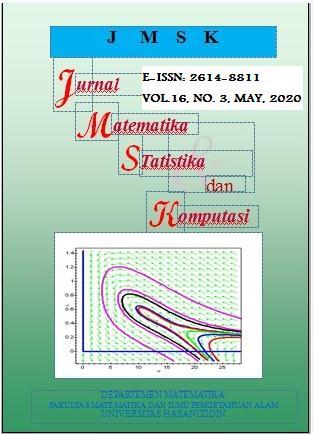Support vector regression (SVR) model for forecasting number of passengers on domestic flights at Sultan Hasanudin airport Makassar
DOI:
https://doi.org/10.20956/jmsk.v16i3.9176Keywords:
ARIMA, SVR, Sultan Hasanudin AirportAbstract
Sultan Hasanudin Airport is one of the largest airports in Indonesia, located in Makassar City. Its strategic location is the entrance of eastern Indonesia because it is a transit airport to other eastern regions of Indonesia. The number of airplane passengers at Sultan Hasanudin Airport has increased and decreased each time depending on certain moments. The increase in the number of passengers is closely related to the moments of religious holidays or year-end holidays. Whereas the decrease in the number of passengers was greatly influenced by the policy of rising plane ticket prices some time ago. Estimated number of passengers every month is needed in planning and making appropriate decisions from the government relating to fluctuations in the number of domestic flight passengers at Sultan Hasanudin Airport. Therefore, accurate forecasting techniques are needed to predict the number of passengers in the future. Because the data pattern of domestic flight passengers at Sultan Hasanudin Airport is not stationary, the ARIMA model can be used. However, the data on the number of passengers has a nonlinear data pattern, so we need a method that can overcome these problems. In this study the SVR model is used to overcome nonlinear patterns in the data. Compared to the ARIMA model, SVR has the advantage because it does not require stationary data assumptions as in ARIMA. The results of forecasting data on the number of domestic flight passengers at Sultan Hasanudin Airport using SVR show better accuracy or accuracy compared to the ARIMA model because it has a smaller MAPE value.
References
Badan Pusat Statistik. Diakses Pada Tanggal 11 Januari 2020 Melalui https://www.bps.go.id/linkTableDinamis/view/id/812
Boser, B.E., Guyon, I., and Vapnik, V. 1992. A Training Algorithm for Optimal Margin Classifiers. Proceedings of the fifth annual workshop on Computational learning theory (COLT) : 144-152.
Cryer, J.D. 1986. Time Series Analysis. Boston : PWS-KENT Publishing Company
Haykin, S. 2009. Neural Networks and Learning Machines, Third Edition. New Jersey : Pearson Education, Inc.
Hsu, C. W., Chang, C.C., and Lin, C.J. 2016. A Practical Guide to Support Vector Classificaton. Taipei : Department of Computer Science National Taiwan University.
Ramsey, J. B. 1969. Tests for Specification Errors in Classical Linear Least Squares Regression Analysis. Journal of the Royal Statistical Society, Series B. 31 (2): 350–371.
Smola, A.J. dan Scholkopf, B. 2004. A Tutorial On Support Vector Regression. Statistic and Computing 14, 199-222.
Vapnik, V.N. 1995. The Nature of Statistical Learning Theory. New York: Springer
Wei, W.W.S. 2006. Time Series Analysis: Univariate and Multivariate Methods, Second Edition. New York : Pearson Education.
Zhang, G.P. 2003. Time Series Forecasting using a Hybrid ARIMA dan Neural Network Model. Neurocomputing 50,159-175.
Downloads
Published
How to Cite
Issue
Section
License

This work is licensed under a Creative Commons Attribution 4.0 International License.
Jurnal Matematika, Statistika dan Komputasi is an Open Access journal, all articles are distributed under the terms of the Creative Commons Attribution License, allowing third parties to copy and redistribute the material in any medium or format, transform, and build upon the material, provided the original work is properly cited and states its license. This license allows authors and readers to use all articles, data sets, graphics and appendices in data mining applications, search engines, web sites, blogs and other platforms by providing appropriate reference.







